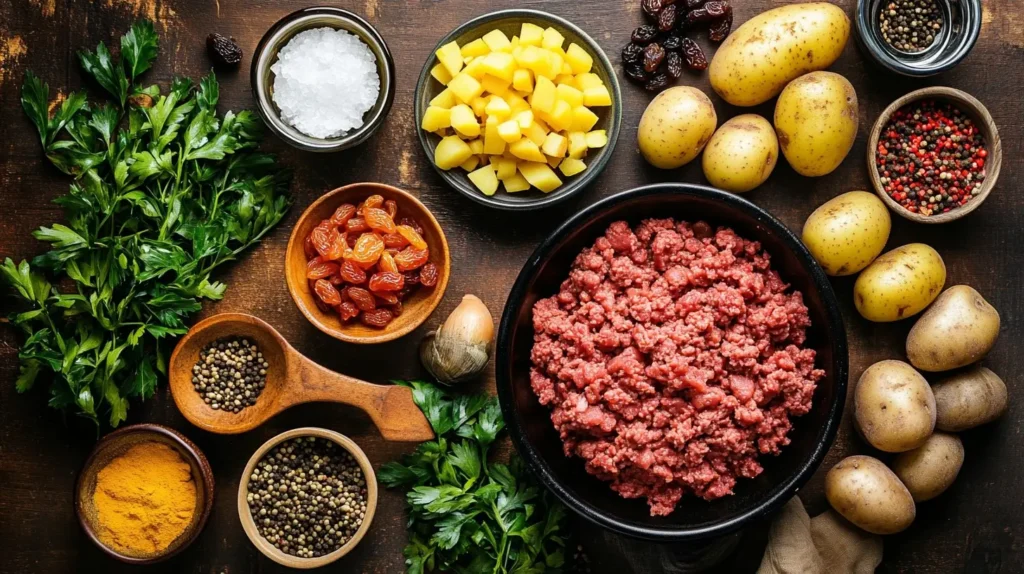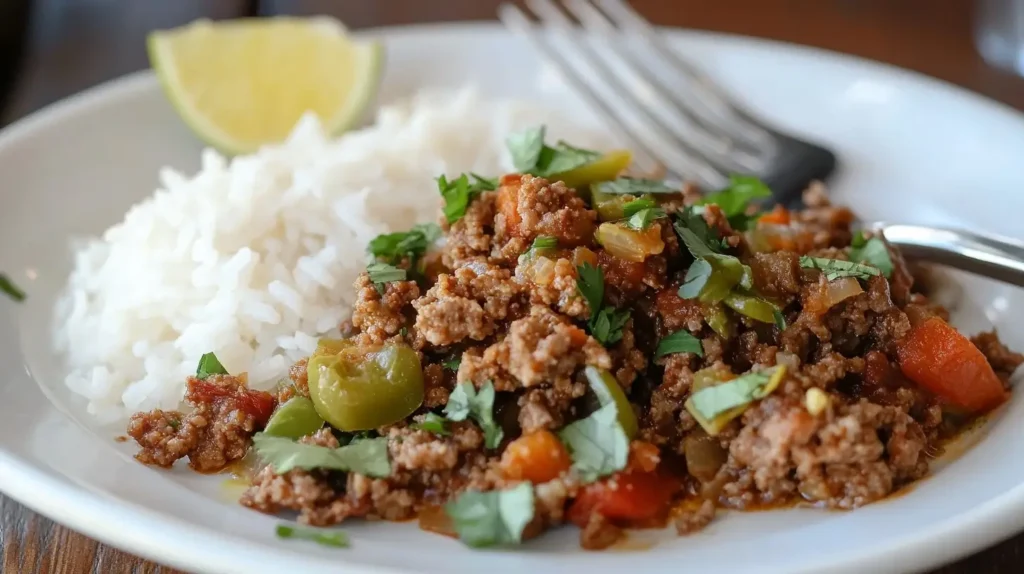Cuban Picadillo is a flavorful and comforting dish that’s cherished in Cuban homes. This dish combines ground beef with sweet and savory ingredients like raisins, olives, and capers. The beauty of Cuban Picadillo lies in its balance—sweet, salty, and tangy all in one bite. It’s a dish that tells the story of Cuba’s rich culinary history and has become a favorite among families around the world.
What is Cuban Picadillo?
Cuban Picadillo is a ground beef hash, simmered with potatoes, olives, raisins, and spices, creating a savory-sweet dish. It’s often served with rice, making it a complete and filling meal. The mix of ingredients like raisins and olives gives it a unique twist compared to other ground beef dishes.
The History and Origins of Cuban Picadillo
Cuban Picadillo is a fusion of Spanish and Cuban flavors. It originated from Spain, with the Spanish colonists introducing similar stews and hash dishes. Over time, Cuban cooks added local ingredients like olives, raisins, and potatoes to make it their own. It’s a dish that has been passed down through generations, evolving into a symbol of Cuban culture.
Key Ingredients for Cuban Picadillo
Here are the main ingredients that come together to create the delicious Cuban Picadillo:

| Ingredient | Quantity |
|---|---|
| Ground Beef | 1 lb (450g) |
| Potatoes | 2 medium, peeled and diced |
| Green Olives | 1/2 cup, sliced |
| Raisins | 1/4 cup |
| Tomato Sauce | 1/2 cup |
| Garlic | 2 cloves, minced |
| Oregano | 1 tsp |
| Cumin | 1 tsp |
| Bay Leaves | 2 leaves |
| Vinegar | 1 tbsp (optional) |
Ground Beef: The Main Protein Source
The primary protein in Cuban Picadillo is ground beef. It’s the base of the dish and is cooked until browned, which helps bring out the rich flavors. Lean ground beef is typically used to keep the dish lighter, though some prefer a bit more fat for extra flavor.
The Role of Potatoes and Olives in Cuban Picadillo
Potatoes provide heartiness and absorb the delicious flavors from the beef and spices. They add texture to the dish while making it more filling. Olives bring a salty contrast to the sweetness of raisins, balancing the flavors perfectly.
Sweetness from Raisins: A Unique Touch
Raisins may seem out of place in a savory dish, but in Cuban Picadillo, they add a surprising sweetness that pairs wonderfully with the savory and salty ingredients. As the raisins cook, they soften and caramelize, contributing to the overall richness of the dish.
Cuban Spices and Seasonings for Authentic Flavor
Seasoning is key to bringing all the ingredients together. Common spices include cumin, oregano, and garlic, which provide depth and warmth. Bay leaves are often added to infuse a subtle, aromatic flavor that ties everything together. The addition of vinegar (optional) adds brightness, cutting through the richness of the beef.
How to Make Cuban Picadillo: Step-by-Step Recipe
Now that we’ve covered the key ingredients, let’s move on to the fun part—cooking the Cuban Picadillo! This dish is not only easy to make, but it’s also very forgiving, allowing you to adjust it to your tastes as you go. Follow these simple steps to create an authentic Cuban Picadillo that will wow your taste buds.
Step 1: Prepare Your Ingredients
Before you start cooking, it’s important to have everything ready. This will make the cooking process much smoother and help you avoid any last-minute scrambling. Here’s what you need to do:
- Peel and dice the potatoes: Chop the potatoes into small, bite-sized cubes so they cook evenly. You want them tender but not mushy, so keep them relatively small.
- Slice the olives: If you’re using whole olives, slice them into rings or small pieces. This ensures the olives distribute well throughout the dish.
- Mince the garlic: Fresh garlic brings so much flavor to the dish, so make sure to mince it finely.
- Get your spices ready: Measure out the cumin, oregano, and have your bay leaves on hand.
Having everything prepped in advance will make your cooking process more efficient.
Step 2: Brown the Ground Beef
Start by heating a tablespoon of oil in a large skillet or Dutch oven over medium heat. Once the oil is hot, add the ground beef. Cook it, breaking it apart with a spatula, until it’s browned and cooked through. This step is crucial because browning the beef helps develop rich flavors.
If there’s excess fat in the pan after the beef is browned, drain it off to avoid making the dish too greasy.
Step 3: Add the Garlic and Spices
Once your beef is browned and drained, it’s time to add the flavoring. Add the minced garlic to the pan and cook it for about 1 minute, or until fragrant. Be careful not to burn it—garlic can go from perfectly golden to bitter quickly.
Now, sprinkle in the cumin, oregano, and bay leaves. Stir everything together so the spices evenly coat the beef. The smell at this point will be absolutely intoxicating!
Step 4: Add Potatoes, Olives, and Raisins
Next, stir in the diced potatoes, olives, and raisins. These ingredients are what make Cuban Picadillo truly unique. The raisins add a touch of sweetness, while the olives give a slightly tangy contrast. The potatoes absorb all the savory and sweet flavors, making each bite comforting and delicious.
Give everything a good stir to make sure all the ingredients are mixed well.
Step 5: Create the Sauce
Now, it’s time to make the dish come together with a flavorful sauce. Pour in the tomato sauce and give it a good stir. The tomato sauce will bring everything together and create a rich, velvety base for the Picadillo.
If you like, add a splash of vinegar (or a little red wine) to cut through the richness. This helps balance out the sweetness of the raisins and the saltiness of the olives.
Add a little water or broth to make sure the mixture isn’t too dry. You want the potatoes to cook in this delicious sauce, so there should be enough liquid to help them soften and absorb all the flavors.
Step 6: Simmer the Picadillo
Once everything is in the pan, lower the heat and cover the skillet. Let the Picadillo simmer for about 20-30 minutes, stirring occasionally. The goal here is to cook the potatoes until they’re tender and allow all the flavors to meld together.
If the mixture becomes too thick or dry, add a little more water or broth to keep it from sticking to the pan. The sauce should be thick but not dry.
Step 7: Taste and Adjust Seasoning
Before serving, taste your Picadillo and make sure the seasoning is right. You can adjust the salt, pepper, or vinegar to suit your taste. If you prefer more sweetness, you can add a few extra raisins or a pinch of sugar.
Don’t forget to remove the bay leaves before serving!
Serving Cuban Picadillo

Cuban Picadillo is traditionally served with white rice, but you can also serve it with fried plantains or a side of beans to round out the meal. The Picadillo’s combination of savory, sweet, and tangy flavors makes it a perfect pairing with simple, neutral sides.
To serve, scoop a generous portion of the Picadillo onto a plate of rice. The meat and potatoes should be tender, and the sauce should coat everything beautifully. Garnish with chopped cilantro or parsley for a fresh touch.
Picadillo Leftovers: What to Do with Extras
Cuban Picadillo makes excellent leftovers! In fact, many say the flavors get even better the next day. Simply store it in an airtight container in the refrigerator for up to 3 days. You can also freeze it for longer storage. Just be sure to let it cool before freezing, and when you’re ready to reheat, warm it up gently in a skillet over low heat.
Variations of Cuban Picadillo
While the classic Cuban Picadillo is delicious as is, there are many ways you can customize it to your liking. Here are a few variations to consider:
Picadillo with Chicken or Pork
If you prefer something other than beef, you can make Picadillo with ground chicken or pork. The process is the same as using ground beef—just substitute the protein of your choice.
Vegetarian Picadillo
For a vegetarian version, substitute the ground beef with lentils, chickpeas, or even tofu. These options will provide the same texture and heartiness without the meat.
Spicy Picadillo
If you like a little heat, add chopped jalapeños or a dash of hot sauce to your Picadillo. The spiciness will add an extra layer of complexity to the dish.
Frequently Asked Questions (FAQs) about Cuban Picadillo
1. Can I make Cuban Picadillo ahead of time?
Yes, Cuban Picadillo can be made ahead of time and actually tastes better the next day as the flavors continue to meld. Store it in an airtight container in the fridge for up to 3 days. You can also freeze it for longer storage—just be sure to let it cool completely before freezing. When reheating, gently warm it in a skillet or microwave.
2. Can I use a different type of meat for Picadillo?
Absolutely! While traditional Cuban Picadillo is made with ground beef, you can easily substitute it with ground chicken, pork, or turkey for a lighter option. The cooking process remains the same; just swap out the protein of your choice.
3. What can I serve with Cuban Picadillo?
Cuban Picadillo is often served with white rice, but you can also pair it with fried plantains, black beans, or a side salad. The sweet and savory flavors of the Picadillo complement the neutral taste of rice, making it a perfect side dish.
Conclusion
Cuban Picadillo is a flavorful, hearty dish that captures the essence of Cuban cuisine. The combination of savory, sweet, and tangy ingredients makes it a unique and memorable meal. Whether you stick to the classic recipe or experiment with variations, Cuban Picadillo is sure to be a hit at your table. Serve it with rice, beans, or fried plantains for a satisfying meal that brings the flavors of Cuba straight to your home.
Looking for a cozy, flavorful soup? Learn how to make the best Roasted Butternut Squash Feta Soup at home with this simple, step-by-step recipe!

